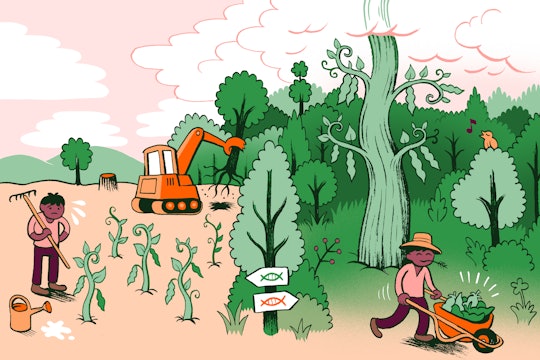
Matteo Farinella
GMOs are better for the environment than you'd think
Although it's not a popular narrative, genetic engineering can be an important ally in protecting the environment
Crops are engineered in a number of ways. Often, they are made resistant to an herbicide, so a farmer can spray one on their fields and keep their plots free from weeds without killing the crop itself. Or they can be innately poisonous to its predators, like milkweed, which reduces the amount of pesticide needed to keep a crop safe.
But do these things harm the environment? According to the data: not really. GM crops appear to be just as sustainable and productive as non-GM crops, if not more so.
"Sustainability," in addition to being a buzzword, is a measure of a local environment's ability to remain diverse and productive. Studies show that choosing to farm either non-GM or GM crops doesn't make much difference when it comes to sustainability. And in both aspects, biodiversity, and productivity, GM agriculture has been performing better than non-GM crops for the last 20 years.
Biodiversity
Any kind of farming inevitably results in biodiversity loss: the immense diversity of forests and woods is cleared for the monotony and monoculture of the crops we need for our food, feed, fibers, and fuel. And this deforestation and agriculture account for 20-30 percent of all greenhouse gases emissions.

Matteo Farinella
But cultivating GM crops has proven better for biodiversity than the conventional alternative, because one way to maintain biodiversity in a local ecosystem is to reduce pesticide use. A GM crop can do this by carrying its own defenses, making pesticides less necessary. For instance, "Bt" corn is engineered to be toxic to predators that would otherwise prey on it. They don't need as much outside assistance in the form of pesticides sprayed over an entire field.
Another upside to GM crops is that the toxin they carry is specific to their predators, making them less harmful than a spray with collateral effects. That means that primary predators like the European corn borer (nicknamed "the billion-dollar bug" because of its heavy effects on the corn market) can be precisely targeted, while leaving other harmless, passerby insects unaffected. Such genetic engineering is remarkably efficient – according to a 2014 meta-analysis, GM-based farming has required 37 percent fewer pesticides than conventional agriculture.
The biodiversity of a field can also be monitored through the levels of insects living on it. A recent meta-study based on 839 publications released over 20 years reaches the conclusion that, worldwide, GM corn does not affect the majority of insect families. Basically, no ladybugs or butterflies were harmed - at least, not more than they would’ve been through conventional agriculture. The only insects that were affected by the Bt-corn were the European corn borer (the intended target), the Western corn rootworm, and other corn pests.
And, finally, an important aspect of biodiversity is the soil in a given area: one teaspoon of soil contains more living organisms than people in the world and soil microorganisms have a crucial impact on the fertility and the sustainability of agricultural systems. For example, the majority of plant roots establish symbiotic relationships with fungi or bacteria living in the soil that both siphons them nutrients and provides protection against root diseases. Soil microbial communities are not affected by GM crops, which interact with soil microorganisms (worms, insect, fungi, and bacteria) in the same way as non-GM crops.
Productivity
The productivity of GM plants is typically 20 percent higher than that of non-GM ones, making it an appealing way to approach the pressures of rising global food demand due to population growth. GM crops are also an appealing approach in the face of climate change and pollution.

Matteo Farinella
As climate change progresses, land becomes more arid, usable topsoil is depleted, and water becomes more scarce. Conventional crops are typically not drought tolerant, and so as human-caused climate change continues, agricultural yields could drop. One study found that each degree of warming will result in anywhere from a 3-7 percent drop in global yield in wheat, rice, corn, and soybean. Tactics to adapt to this include engineering crops to retain more water, or adding genes that essentially stabilize cells, make them hardier, and hopefully able to withstand the stresses of a drought.
We have gathered enough data in research performed over 20 years in different parts of the world to show that GE crops are generally beneficial to the environment, given their reduced land usage, need for pesticides, and lack of off-target effects. If we continue to engineer plants for other characteristics (like, say, improved photosynthesis and enhanced plant growth, which would increase yield and reduce land usage further), genetic engineering can be an important ally in protecting the environment and achieving more sustainable agriculture.
